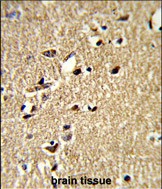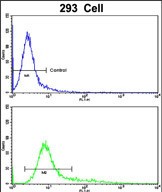SDCCAG33 Antibody (Center)
Purified Rabbit Polyclonal Antibody (Pab)
- SPECIFICATION
- CITATIONS
- PROTOCOLS
- BACKGROUND

Application
| FC, IHC-P, WB, E |
|---|---|
| Primary Accession | Q6ZSZ6 |
| Reactivity | Human, Mouse |
| Host | Rabbit |
| Clonality | Polyclonal |
| Isotype | Rabbit IgG |
| Calculated MW | 117916 Da |
| Antigen Region | 656-685 aa |
| Gene ID | 10194 |
|---|---|
| Other Names | Teashirt homolog 1, Antigen NY-CO-33, Serologically defined colon cancer antigen 33, TSHZ1, SDCCAG33, TSH1 |
| Target/Specificity | This SDCCAG33 antibody is generated from rabbits immunized with a KLH conjugated synthetic peptide between 656-685 amino acids from the Central region of human SDCCAG33. |
| Dilution | FC~~1:10~50 IHC-P~~1:50~100 WB~~1:1000 E~~Use at an assay dependent concentration. |
| Format | Purified polyclonal antibody supplied in PBS with 0.09% (W/V) sodium azide. This antibody is prepared by Saturated Ammonium Sulfate (SAS) precipitation followed by dialysis against PBS. |
| Storage | Maintain refrigerated at 2-8°C for up to 2 weeks. For long term storage store at -20°C in small aliquots to prevent freeze-thaw cycles. |
| Precautions | SDCCAG33 Antibody (Center) is for research use only and not for use in diagnostic or therapeutic procedures. |
| Name | TSHZ1 |
|---|---|
| Synonyms | SDCCAG33, TSH1 |
| Function | Probable transcriptional regulator involved in developmental processes. May act as a transcriptional repressor (Potential). |
| Cellular Location | Nucleus. |
| Tissue Location | Expressed in brain; strongly reduced in post-mortem elderly subjects with Alzheimer disease. |

Thousands of laboratories across the world have published research that depended on the performance of antibodies from Abcepta to advance their research. Check out links to articles that cite our products in major peer-reviewed journals, organized by research category.
info@abcepta.com, and receive a free "I Love Antibodies" mug.
Provided below are standard protocols that you may find useful for product applications.
Background
SDCCAG33 is a colon cancer antigen that was defined by serological analysis of recombinant cDNA expression libraries. This protein is a member of the teashirt C2H2-type zinc-finger protein family and may be involved in transcriptional regulation of developmental processes.
References
Core,N., Caubit,X., et.al., Dev. Biol. 308 (2), 407-420 (2007)
Scanlan,M.J., et.al., Int. J. Cancer 76 (5), 652-658 (1998)
If you have used an Abcepta product and would like to share how it has performed, please click on the "Submit Review" button and provide the requested information. Our staff will examine and post your review and contact you if needed.
If you have any additional inquiries please email technical services at tech@abcepta.com.













 Foundational characteristics of cancer include proliferation, angiogenesis, migration, evasion of apoptosis, and cellular immortality. Find key markers for these cellular processes and antibodies to detect them.
Foundational characteristics of cancer include proliferation, angiogenesis, migration, evasion of apoptosis, and cellular immortality. Find key markers for these cellular processes and antibodies to detect them. The SUMOplot™ Analysis Program predicts and scores sumoylation sites in your protein. SUMOylation is a post-translational modification involved in various cellular processes, such as nuclear-cytosolic transport, transcriptional regulation, apoptosis, protein stability, response to stress, and progression through the cell cycle.
The SUMOplot™ Analysis Program predicts and scores sumoylation sites in your protein. SUMOylation is a post-translational modification involved in various cellular processes, such as nuclear-cytosolic transport, transcriptional regulation, apoptosis, protein stability, response to stress, and progression through the cell cycle. The Autophagy Receptor Motif Plotter predicts and scores autophagy receptor binding sites in your protein. Identifying proteins connected to this pathway is critical to understanding the role of autophagy in physiological as well as pathological processes such as development, differentiation, neurodegenerative diseases, stress, infection, and cancer.
The Autophagy Receptor Motif Plotter predicts and scores autophagy receptor binding sites in your protein. Identifying proteins connected to this pathway is critical to understanding the role of autophagy in physiological as well as pathological processes such as development, differentiation, neurodegenerative diseases, stress, infection, and cancer.




